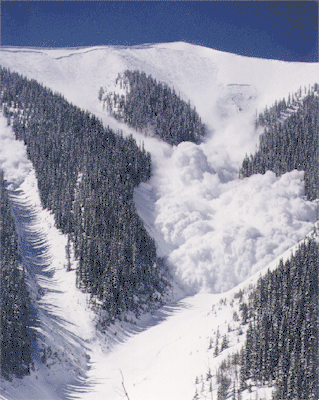 While the recent storm brought much welcomed snow to the region, it also brought another round of dangerous avalanche conditions in the backcountry. Areas around Rocky Mountain National Park (just 45 minutes north of Nederland) received up to 52 inches of new snow. Colorado has more people die from avalanches annually than any other state in the country, and for good reason. In spite of the twenty-five lift-served ski resorts, there are many more mountainous areas that have wonderful chutes and bowls that appeal to backcountry skiers. For those who chase powder, its appeal is undeniable. Because there is so much terrain to ski relative to the number of skiers, you are almost guaranteed a powder run after any new snow storm. But there is an inherent risk…
While the recent storm brought much welcomed snow to the region, it also brought another round of dangerous avalanche conditions in the backcountry. Areas around Rocky Mountain National Park (just 45 minutes north of Nederland) received up to 52 inches of new snow. Colorado has more people die from avalanches annually than any other state in the country, and for good reason. In spite of the twenty-five lift-served ski resorts, there are many more mountainous areas that have wonderful chutes and bowls that appeal to backcountry skiers. For those who chase powder, its appeal is undeniable. Because there is so much terrain to ski relative to the number of skiers, you are almost guaranteed a powder run after any new snow storm. But there is an inherent risk…
During the ebbs and flows of temperature throughout the winter, the old snow can thaw and then freeze rock solid. When a new storm drops snow on top, it becomes very unstable. The steeper the slope, the more likely it is that it may slide. A big part of ski patrol’s job at a ski resort is mitigating avalanches through blasting, boot-packing and other means. It is their job to make sure terrain that is open to the public in bounds is safe.
But in the backcountry, it’s up to the skier’s own judgment. I experienced this first-hand while living in Lake Tahoe. My friend suggested we go backcountry skiing in Lassen National Park after almost two feet of powder fell. When we arrived at the park, I felt a sense of foreboding reading the signs the Park Service had posted saying, “Extreme Avalanche Danger.” Right then, I should have spoken up and refused to go. But my friend was an experienced skier and we hooked up with a father and son, who were also experienced and had avalanche probes and a full set of gear with them. And so I went along. My friend and I erred right from the get go in that we did not wear avalanche beacons, which all backcountry skiers should take with them. If caught in an avalanche, the beacon goes off, alerting searchers to the exact location of the skier.
On that trip, everything seemed fine, as the four of us climbed up the mountain, sticking to ridges along the way. Since backcountry skiers don’t have a lift to take them up, they must climb themselves. Most skiers apply “skins” to the bottom of their skis. Skins have a sticky adhesive on the one side to stick to the bottom of the ski, and a furry type material on the reverse side that sticks to the snow. They allow the skier to walk up the mountain on their skis.
After we reached the top, we all started to ski down. My friend decided to take a different route than the father and son, and that’s where we ran into trouble. Rather than skiing down the ridges, he decided to head down a bowl. I was standing on top of the ridge, when he took about four turns and yelled up at me. “Don’t move!” He had cut an avalanche right at his feet. He took his skis off, and gingerly walked back up to me. Fortunately, for both of us, the avalanche fell right below him, and neither one of us were swept away. We slowly skied down the ridges from that point forward, and as we neared the parking area, could see how vast that avalanche was. I learned my lesson then, and stay away from any backcountry skiing, sticking instead to the ski resorts.
Years later, a very good friend of mine from Lake Tahoe was killed in an avalanche in Canada, which reinforced the message of how dangerous the backcountry can be. One of the best resources for finding about avalanche danger is through the Colorado Avalanche Information Center, which provides key information regarding risk throughout Colorado. Skiing is one of the best things about living in Colorado, but we all need to pay attention to our instincts and play it safe during ski season, especially in the spring time.

